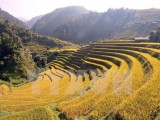Sa Huynh Salt Village in Quang Ngai
Sa Huynh salt village is located in Duc Pho district 60 kilometers south of Quang Ngai city. Sa Huynh has a beautiful beach and is well-known in the central region as a salt-making area.
From the section of Highway 1A that runs through Sa Huynh village, the salt fields look like mirrors sparkling in the sunlight.
Sa Huynh was originally named Sa Hoang, which means 'yellow sand'. Local elders say they had to change the name to Sa Huynh because “Hoang” was the name of Lord Nguyen Hoang of the Nguyen Dynasty. During the Nguyen Dynasty in the 19th century, Sa Huynh held an important position in guarding national territorial waters. Later the salt-making craft was established and has been maintained ever since.
Sa Huynh currently has 550 households and about 2,000 of its inhabitants are involved in salt making. With a production area of over 116 hectares, the village turns out an average annual volume of 9000 tons of salt. The salt season is from March to September.
Salt making is hard work. Salt workers, a majority being women, do manual work under the scorching sun of the central region.
Pham Thi Vang, a Pho Thach villager, told VOV “The salt-making process is as follows: We direct sea water into the fields. Then we have to wait for the sun to evaporate the water, leaving just the salt.”
Nguyen Thi Be, a veteran salt worker, recalled that in the past many villagers had to find new jobs because of an unstable market. Men got involved in ship building, fishing, or construction. Women wove fishing nets, started small businesses, or offered tourism services, as Be and her family are now doing.
“In the past our ancestors didn’t know what to do for a living besides make salt. They made salt from January to July and put enough aside for the whole year. My entire family earned less than US$880 a year. Now our income is from salt, raising fish, shrimp, and oysters, and providing tourism services. Our income has greatly improved,” said Be.
With government support, Sa Huynh villagers have invested tens of thousands of USD into new production models. Nearly 7 km of dikes have been constructed and one third of the area of salt fields has been paved. This has improved the quality of Sa Huynh salt. It is now a favorite of consumers and is used by the seafood processing industry. As a result, its market has expanded across the central and central highlands regions. Sa Huynh now is one of the three biggest salt producers in Vietnam.
Though its infrastructure remains poor, Sa Huynh's tourism has been growing. From a tiny fishing village Sa Huynh has become an attractive town steadily growing in popularity. Visitors come to enjoy the unspoiled beach, explore the ancient culture, learn about the life of the salt makers, sample the local food specialties, and see the vast fields of salt.
VOV5
 Vietravel expands business in Indian market
Vietravel expands business in Indian market
 2025 Nha Trang – Khanh Hoa Sea Festival to spotlight cultural heritage space
2025 Nha Trang – Khanh Hoa Sea Festival to spotlight cultural heritage space
Vietnam, a unique destination attracting Indian tourists: Indian newspaper
 Cao Bang eyes new opportunities for cross-border tourism development
Cao Bang eyes new opportunities for cross-border tourism development
 Kien Giang strives to attract tourists to finish the year on high note
Kien Giang strives to attract tourists to finish the year on high note
 Rivers provide major resources to boost Vietnam’s tourism
Rivers provide major resources to boost Vietnam’s tourism
 Dong Thap plants over 100 ha of flowers for Tet
Dong Thap plants over 100 ha of flowers for Tet
 Donghai Airlines launches direct route to Khanh Hoa
Donghai Airlines launches direct route to Khanh Hoa
 “Carbon footprint” reduction needed for sustainable tourism development: insiders
“Carbon footprint” reduction needed for sustainable tourism development: insiders
Vietnam's tourism likely to boom under 'Six Countries, One Destination' visa initiative




